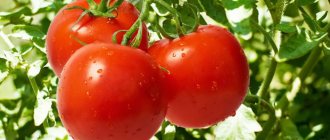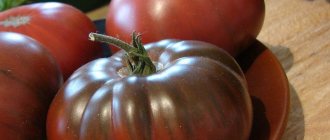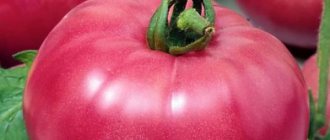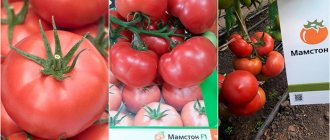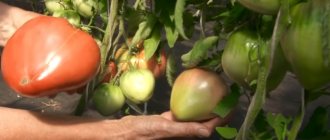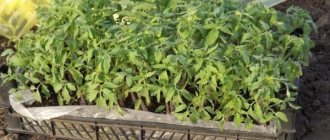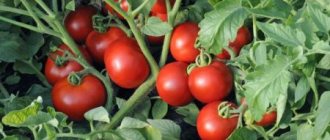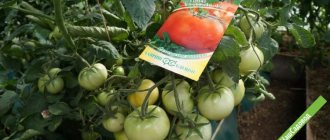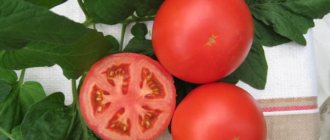Description of the variety
The tomato gets its name from its brown color. The Negritenok variety belongs to a variety of black-fruited tomatoes. The anthocyanin it contains gives the tomato an unusual color for these vegetables. However, it is not entirely true to talk about black tomatoes.
In fact, due to the purple pigment, tomatoes acquire the color of the fruit:
- from brown-green to brown-red-brown - the shade of both the skin and the pulp;
- blue-violet - only the skins, the flesh is red.
The variety was developed by agricultural breeding specialists. The tomato was included in the State Register of the Russian Federation in 2010. The originators recommend growing it in open ground and greenhouses in all climatic zones of our country.
Distinctive features
Mid-season, indeterminate variety. Fruit ripening occurs at 110-115 days. The maximum height of the bush is 3.5 m. Medium leafy, the leaves are dark green, oblong, medium in size with a small fluff. The first inflorescence is formed after the 13th pair of leaves, on each raceme there are from 6 to 8 ovaries.
The roots of the plant do not go deep into the ground, they are located close to the surface, but grow in width.
Tomatoes tolerate temperatures down to +7 degrees.
Fruit characteristics, yield
From the description above and the photo it is clear that the fruits are dark brown in color. They acquire this color at the moment of biological ripeness; before that, green tomatoes have a dark brown-green spot at the stalk.
Other characteristics of tomatoes:
- flat-round shape;
- slight ribbing at the stalk (pronounced in large fruits);
- thick skin;
- juicy, medium-density red flesh;
- many chocolate-colored seeds (6 seed chambers);
- sweet and sour taste, tomato aroma;
- the weight of one fruit is from 150 (upper clusters) to 350 g (lower clusters).
The first fruits ripen 110-115 days after emergence. Productivity is low: from 1 sq. m, 6.5-8 kg are collected, on average - 1.5-2 kg of berries per bush.
Fruit characteristics
The Negritenok tomato is more suitable for those vegetable growers who are focused not so much on obtaining record harvests, but on tasty, delicious and very healthy fruits for summer consumption.
The shape of these tomatoes is traditional, round. At the base of the fruits, especially large ones, slight ribbing is often observed. The skin is smooth, the flesh is medium in density, quite juicy. The number of seed nests is 4-6 pieces.
Unripe fruits have the most common green color with a dark green spot at the stalk. As the fruit ripens, the color of the fruit becomes darker, especially at the base of the stalk. In general, tomatoes turn purple.
The tomatoes are not very uniform in size. The first fruits on the lower cluster are distinguished by their large mass - sometimes up to 300-400 grams. The rest of the tomatoes are not at all that large, their average weight is 120-160 grams.
Advice! To obtain really large fruits, up to 350 grams, the bushes must be formed into one stem and no more than 3-4 plants per square meter must be planted.
The taste of tomatoes of this variety is rated good and excellent. According to many reviews, the sweetish and delicious taste of Negritenok fruits is very attractive. Others find it a little bland.
Negritenok tomatoes are best consumed fresh, in salads. Due to their rather large size, the fruits are not very suitable for pickling and pickling in jars. But these tomatoes produce very tasty dark aromatic tomato juice. They are also good for drying and freezing. They will also make original pastas and sauces.
Tomatoes of this variety can be stored well for up to 1.5-2 months, and can, if desired, gain color at home.
How to grow seedlings
Sow seeds for seedlings 60-65 days before transplanting into the ground: in the first half of March.
Important ! Check the expiration date of store-bought seeds (maximum 2-3 years). Seeds collected independently, on the contrary, take older ones - at least 2-3 years after collection.
Seed preparation
Before planting, prepare seed material to increase the germination of grains and the vitality of seedlings:
- Sort through the seeds: select seeds that are larger, smoother and not empty to the touch. Place them in a saline solution for 15-20 minutes (1 tablespoon of salt per glass of water). Select the grains that have sunk to the bottom.
- Warm up the seeds on a central heating radiator: place them on a cotton cloth on a radiator for 1.5-2 days.
- Disinfect the grains with a 1% solution of potassium permanganate (1 teaspoon of potassium permanganate per 600 g of water) for 15-20 minutes. Be sure to rinse with clean water afterwards.
- Enrich the seeds with oxygen: place in warm water (+26+30 degrees) and stir every 60 minutes for 15-18 hours (if you have an aquarium compressor, use it).
- The seeds of many crops are protected by a thin film layer, which dissolves after a long stay in moist soil. Therefore, they require mechanical or hydraulic action to accelerate the germination process. Experts recommend a method using water and gas - bubbling. Oxygen helps accelerate seed germination, improves the development of seedlings and the growth of tomatoes.
- Soak the seeds in warm (+21 degrees) water or biostimulants (Zircon, Epine, Sodium Humate or liquid Energen).
- Harden the planting material: wrap the seeds in cotton cloth and plastic wrap and place them in a cool place with an air temperature of -3+2 (for example, in a refrigerator, on a balcony) for 8 hours. Then keep the seeds at room temperature for 8 hours. Repeat the procedure 5-6 times.
- Germination of grains. Moisten a cloth or gauze with warm water and place on a flat dish. Place the seeds, cover them with another layer of damp cloth and place them in a warm place. Keep the fabric damp at all times and wait for the embryos to appear. When they reach a size of 2-3 cm, plant them in the ground.
Container and soil
For seedlings, choose any convenient container: plastic cups, cut PET bottles, special containers. Before use, disinfect the container with a strong solution of potassium permanganate.
Buy a universal soil for tomatoes. It will definitely include:
- humus;
- river sand;
- peat or coconut substrate.
Or prepare the soil yourself by mixing:
- 1 part of garden land;
- 2 parts non-acidic peat (pH 6.5) or coconut substrate;
- 0.5 parts sand (river or washed);
- 1 part humus or sifted mature compost.
Add sifted wood ash or dolomite flour, sphagnum moss and fallen pine needles.
Pour boiling water or potassium permanganate solution over the finished mixture.
Sowing
Spread the seeds and sprinkle with a 5-7 mm layer of soil. Moisten the soil with a sprayer or spoon. Cover the containers with film and place in a warm (+24 degrees) place. When the shoots appear, lower the temperature: during the day to +12 – +15, at night to +8 – +10 degrees, remove the film and place the seedlings in a bright place. Provide the seedlings with 11 hours of daylight. If natural light is not enough, supplement the plants with fluorescent or LED lamps in the red or blue spectrum.
It is important to install lighting fixtures correctly. Correct the location of the light bulbs if:
- Burns appear on the leaves - increase the distance between the lamps and the plants.
- The leaves have become paler and the stem has become longer - bring the light source closer.
- The lamp is on the side and the stem is bent towards the light - place the lamps strictly above the plantings.
Growing and care
Pick up the plants in the phase of 4 true leaves, digging the seedlings down to the cotyledon leaves. Add mineral fertilizers to the soil for replanting (1 tbsp per 5 liters of soil mixture).
After 10-14 days, feed with complex fertilizer. Repeat this every 2 weeks.
Water as the soil dries with warm water under the root, avoiding water getting on the castings and stem. Use a syringe or spoon for this.
Continue supplementary lighting if daylight hours are less than 12 hours.
Start hardening the seedlings 20 days in advance. In the first 5 days, take it out into the open air for 3-4 hours during the day. After that, add an hour a day. 4 days before moving, leave the seedlings overnight to acclimate them to night frosts.
Growing rules
The breeding tomato variety “Negritenok” is not a hybrid, so tomatoes are grown with pre-harvested seeds or seeds purchased from a retail chain. The variety is planted as seedlings in a permanent place. You can grow planting material yourself or purchase it in a store.
Planting seedlings
Planting of the variety is carried out at the end of February, beginning of March. By the time the seedlings are planted in a permanent place, the soil will have warmed up; the timing of seed planting must be determined taking into account the weather conditions of the region. February and March are the optimal time for placing seedlings in greenhouses, if you plan to sow seeds in open ground in mid-March. Sequencing:
- The seeds of the variety are disinfected by placing them in a “Fitosporin” solution for 30 minutes, then a growth stimulant is placed in the preparation for 5 hours.
- Planting soil, peat with added organic matter, is treated with a manganese solution.
- Containers for seedlings are doused with boiling water, and soil is laid out in them.
- Make furrows 2–3 cm deep 10 cm between rows and sow planting material.
- The container is covered with glass or transparent film on top and placed in a place accessible to ultraviolet radiation.
- After the sprouts appear, the covering material is removed.
Seedlings of the Negritenok variety grow for three weeks, watering is carried out as the top layer of soil dries out. When the tomatoes produce 4 leaves, it is necessary to dive. The variety can be replanted into a larger container so that there is 10 cm between the young shoots; the best option is peat cups. Each plant is transplanted, after planting it grows for about 1.5 months and approximately at the end of May is placed in a permanent place of growth.
Tomato transplant
Before placing the “Negritenok” tomato seedlings, prepare the area or soil in the greenhouse. The soil is loosened, weeds are removed, and organic and phosphorus fertilizers are applied.
Advice! Planting the variety in an open area, possibly after warming up the soil, the temperature should not be lower than +7 °C.
The distance between rows is 70 cm, between bushes 40 cm, approximately per 1 cubic meter. m there are 3 plants. Seedlings are planted in open ground at the end of May, and in a greenhouse a week earlier.
Subsequent care for tomatoes
In the period before the first flowering, the Negritenok tomato is given its first fertilizing with products that contain ammonia. The next tomatoes receive phosphorus fertilizer during fruit formation. Throughout the entire growing season, Negritenok tomatoes are watered once every seven days. Loosen the soil as a crust forms and remove weeds.
The bush of the “Negritenok” variety is indeterminate, so the formation of the plant is required. One main stem is left, rarely 2, the second is the first strong shoot. All stepsons are removed immediately and as the tomato grows. After harvesting, used brushes and leaves are cut off. A prerequisite for agricultural technology of the Negritenok variety is tying the main tomato stem to a support or trellis.
How to grow tomatoes
Tomatoes are transplanted to a permanent location in May. At the beginning of the month - in greenhouses, in the middle and end - in open ground.
Landing
Before placing Negritenok tomato seedlings, prepare the area. Loosen the soil, remove weeds, apply organic and phosphorus fertilizers. A day before planting, treat the soil with a solution of potassium permanganate or boiling water to destroy possible infections or pest larvae.
Planting pattern – 40x60 cm. Plant tall seedlings at an angle, sprinkled with soil. This promotes the development of an additional root system and ensures better growth and development of the plant.
Care
Water the plants once every 7-10 days with warm water at the roots. With each watering, remove weeds and loosen the soil to ensure oxygen supply to the rhizome.
Before the first flowering, feed the tomatoes with ammonia fertilizer. During fruit formation, apply phosphorus fertilizer.
Form plants into 1-2 stems. Remove suckers and lower leaves regularly. Tie the tomatoes to a support and continue tying as the bush grows. Pinch the top when the bush reaches 2 meters in height.
Features of cultivation and possible difficulties
Black-fruited tomatoes do not differ in care from red ones, and there are no difficulties in caring for them.
Tomatoes ripen unevenly, so as soon as the bunch has given up all the fruit, cut it off.
Diseases and pests
According to the originators, the variety is immune to common tomato diseases. To prevent fungal diseases in greenhouses, as well as in cool, rainy summers in open ground, treat plantings with Fitosporin.
Of the harmful insects, Negritok is attacked by terrestrial pests (Colorado beetles, whiteflies, slugs) and underground (chafer beetle larvae and wireworms).
Treat the plantings against the Colorado potato beetle with Prestige, against whiteflies with Confidor, and against slugs with the biological additive parasitic nematode.
Important ! Beetle poison will help against the Colorado potato beetle. Collect a liter jar of adults, pour into a 20 liter bucket and fill to the brim with water. After the beetles die (they sink to the bottom), infuse the poison for another week. Spray the tomatoes with a freshly prepared solution diluted with water (1:1, 1:2 - select the required proportion yourself). To prevent slugs, spray tomatoes with a solution of ammonia (dissolve 4 tablespoons of alcohol in a bucket of water).
Pre-planting soil treatment will help against underground pests: dig up the area in the fall, and the eggs will die from frost. The wireworm does not like calcareous soil, and the larvae of the cockchafer do not like soil rich in nitrogen. Mulch the bushes with straw (sawdust, mown grass) soaked in nitrogen-containing fertilizers:
- urea;
- ammonium nitrate;
- old manure.
Growing rules
No matter how high-quality the seed is, the final result depends only on the vegetable grower. When growing early ripening varieties, some subtleties should be taken into account. No one other than a vegetable grower will be able to assess the peculiarities of the local climate in order to choose the right time for growing the Red Truffle tomato in open ground or a greenhouse.
Planting seedlings
The variety is propagated traditionally - by seedlings. When sowing seeds for seedlings, it must be taken into account that the tomato belongs to the early ripening varieties. The optimal time for sowing seedlings for unheated greenhouses is considered to be March 15-20, for unprotected soil - April 1-10.
Tomato seeds are deepened by 1-1.5 cm. Then sprinkled with a small layer of soil. The optimal ratio of soil components is: turf soil, humus or manure, sifted sand in a ratio of 2:2:1. Immediately after planting, the seedling container is covered with glass or film until germination and placed in a room with a temperature of + 20-24 °C.
Picking of seedlings is carried out after the appearance of 1-2 full-fledged leaves. This procedure stimulates the development of the root system. Tomato seedlings need regular feeding. To prepare the plants for transplanting, they should be fertilized with potassium and phosphorus a week before. Seedlings should be watered sparingly, avoiding rotting of the roots.
7-10 days before transplanting tomatoes to a permanent place, the boxes begin to be taken out into fresh air in order to adapt the seedlings of the Red Truffle tomato variety to external conditions. Hardening occurs in stages, by gradually increasing the time the tomato seedlings spend in natural conditions.
Tomato transplant
Transplantation of seedlings to a permanent place occurs 50-55 days after germination. At this point, the seedlings already have a flower cluster, buds have formed, but have not bloomed.
Important! Transplantation must be done before the flowers bloom. Otherwise, the ovaries are likely to fall off. Seedlings can be planted in heated greenhouses as early as April
Seedlings are moved to unheated greenhouses in mid-May. When transplanting seedlings into unprotected soil, they are guided by the average daily air temperature, the optimal value is + 12-15 ° C. When there is a threat of night frosts, plantings are protected with covering material
Seedlings can be planted in heated greenhouses as early as April. Seedlings are moved to unheated greenhouses in mid-May. When transplanting seedlings into unprotected soil, they are guided by the average daily air temperature, the optimal value is + 12-15 ° C. When there is a threat of night frosts, plantings are protected with covering material.
Subsequent care for tomatoes
Caring for tomatoes in a permanent location involves watering, loosening and feeding the plants.
It is necessary to water the bushes abundantly, but not often - once every 3-4 days. If the season is hot, then water the tomatoes every other day. It is preferable to carry out the procedure in the evening with warm water. After watering, the soil should be loosened and mulched.
An important process in caring for tomatoes is the formation of bushes. In the case of determinate type tomatoes, 2-3 stems are left on the bush. The optimal number of clusters on one shoot is 5 pieces with 4-6 fruits on each. Pinching, the process of removing additional side shoots, is used sparingly on the Truffle Red variety.
As a rule, leaves of determinate varieties are not removed due to the short growing season. Removing the lower leaves is possible if necessary and if they are unnecessary. They are usually picked after the fruits ripen. This manipulation reduces the likelihood of tomatoes cracking due to excessive watering.
During the entire growth cycle of tomatoes, one should not forget about fertilizers. The first feeding of plants is carried out 7-10 days after planting and then every 10 days until the first fruits are the size of a walnut.
For bushes in a greenhouse, an additional care item is regular ventilation.
The nuances of growing in open ground and in a greenhouse
In the greenhouse, increase the distance between rows to 70 cm. Ventilate structures frequently.
When planting in open ground, check that the air temperature at night does not drop below +7 degrees. Tomatoes planted in cold soil or damaged are susceptible to root rot.
The photo shows that the disease affects the neck of the stem. Treatment is effective only at the beginning of the development of the disease, because the fungus quickly affects the entire bush and the plant dies. Even if you manage to cure the tomatoes, the bushes affected by rot will be stunted in growth and produce a low yield.
Tomato “Negritenok”: original color and harmonious taste
One of the black-fruited varieties that some summer residents have already tried is the “Negritenok” tomato.
Some reviews about this interesting tomato and its photos will be of interest to those summer residents who plant original plants on their plots. Tomatoes of this variety were obtained by Russian breeders about 10 years ago and belong to a series of proprietary varieties.
The plant is a mid-early, indeterminate type, intended for cultivation in open ground and film greenhouses throughout Russia. Get acquainted with the properties of the Negritenok tomato, its characteristics and description of the variety, which, according to reviews, corresponds to it.
Advantages and disadvantages of the variety
The advantage of the variety is the unusual color of the fruit. In addition, tomatoes:
- Long fruiting period.
- Good taste and aroma.
- Immunity to infections and diseases of tomatoes.
- There is no need for frequent watering.
- Possibility of long-term storage and transportation.
- Versatility of use.
Important ! The fruits have a high content of antioxidants, which promote accelerated cell recovery. They slow down the aging process and reduce the inflammatory response. Some scientists believe that antioxidants minimize the risk of cancer. The increased content of lycopene helps prevent heart and vascular diseases, atherosclerosis, and strengthen the immune system. Carotene improves vision.
The disadvantages of the variety include:
- the need for pinching and gartering bushes;
- crop instability;
- The tomato is not suitable for growing for sale.
What are the benefits of black tomatoes?
Tomatoes of purple or chocolate color are rich in ascorbic acid, which protects the body from colds and strengthens the immune system. Anthocyanins present in black tomatoes function as a natural antioxidant:
- Relieves inflammation.
- Prevents cell degeneration.
- Calms the nerves.
- Eliminate swelling.
The benefit of black fruits is that when consumed regularly, they strengthen blood vessels and have a positive effect on the heart muscle. B vitamins promote rejuvenation of the body, lycopene prevents the development of cancer.
Potential Harm
Black fruits, like red tomatoes, are not recommended for people who suffer from nephrolithiasis. Tomatoes have a diuretic effect and can dislodge stones. If you have an individual intolerance to one of the components present in the composition, dark tomatoes cause allergies; they do not cause harm to other people, but only benefit.
Specific taste
Some summer residents who planted black tomatoes indoors say that they did not like the fruits because they have little acid and a sweetish taste. Some consider this a disadvantage, others - an advantage.
Farmer reviews
Below we provide reviews from summer residents who have tried to grow Negritenok tomatoes on their plots. They note that they are planted not for a high yield, but to obtain unusual black fruits with a pleasant taste.
Igor Pankov, Krasnodar region: “I’ve been growing vegetables, it seems, all my life; in rural conditions it’s not difficult. There are tomatoes of different colors on the plot, among them the Negritenok tomato. The unusual coloring is emphasized by nearby yellow-fruited species. The tomato is tasty, not sour, and the first clusters ripen quickly. I have it growing in an open area. The variety does not like shade and drafts; it is best to determine the planting location on the south side behind the wall of the building.”
Svetlana Khramova, Voronezh region:
“I have been growing the Negritenok tomato variety for a long time; the priority is not high yield, but taste and unusual appearance. I plant tomato seedlings in the greenhouse in early May. When forming a future bush, I leave one stem at a time. They grow in a greenhouse until the night temperature reaches +10 °C, then I remove the film from the roof and sides. The trellis is solid – 2 m high. This is the end point of growth; at this level I break the top. When open, the tomatoes grow until September, then I cover the greenhouse again until frost.”
Nadezhda Sonina, Rostov region: “From 5 seeds 4 bushes grew, tall and strong. They were green all summer. I let them grow in one stem, shaped them, tied them up. But on the luxurious bushes only 4-5 tomatoes grew and ripened. Moreover, the first brush formed very late, only after the 14th leaf. The tomatoes were large, beautiful, very tasty, but so few! I liked their taste so much that I chose the seeds to sow next year. I will try again."
Olga Gradova, Kemerovo: “Negritenok’s seedlings were the most ordinary. Just stretched out a little. I planted them both in open ground and in a greenhouse, and they all started well. The bushes grew very powerful and beautiful, but they tied worse than other varieties. The first fruits were large and beautiful, then they became much smaller and remained green, they did not have time to ripen. They matured while lying in the room and even acquired brown spots. The harvest was average, but I’m glad about this, because it’s so nice to grow such exotic plants.”
Varieties of black tomatoes for greenhouses
Greenhouse black tomatoes are universal in purpose. Good both fresh and for processing. Varieties with fruit sizes of 40-60 g are ideal for whole-fruit canning. A harvest in closed ground will always please tomato growers. Among the greenhouse varieties there are many varieties of early and mid-early ripening.
| Black Pearl |
The ripeness period is early.
- It is characterized by indeterminateness.
- The tomatoes are smooth, flat-round, small, dense, black-brown.
- Fruit weight is about 39 g. The taste is good.
- Harvest from 1 m² – 9.1 kg.
| Blueberry dessert |
The ripeness period is early.
- It is characterized by indeterminateness.
- The tomatoes are medium-ribbed, flat-round, medium-dense, black-violet-brown.
- Fruit weight is about 119 g. The taste is good.
- Harvest from 1 m² – 5.8 kg.
| Romantic |
The ripeness period is early.
- Support pegs are required. It is characterized by indeterminateness.
- The tomatoes are flat-round, slightly ribbed, medium-dense, black-greenish-brown.
- Fruit weight is about 55 g. The taste is good.
- Harvest from 1 m² – 11.2 kg.
| Monisto chocolate |
The ripeness period is mid-early.
- It is characterized by indeterminateness.
- The tomatoes are smooth, round, small, dense, black and brown.
- Fruit weight is about 39 g. The taste is good.
- Harvest from 1 m² – 8.4 kg.
| Naomi |
The ripeness period is mid-early.
- It is characterized by indeterminateness.
- The tomatoes are slightly ribbed, round, medium, dense, black-brown.
- Fruit weight is about 119 g. The taste is good.
- Harvest from 1 m² – 9.9 kg.
| Black gourmet |
The ripeness period is mid-early.
- It is characterized by indeterminateness.
- The tomatoes are smooth, round, medium, medium-dense, black-brown.
- Fruit weight is about 109 g. The taste is excellent.
- Harvest from 1 m² – 5.6 kg.
| Amigo |
The ripeness period is mid-early.
- It is characterized by indeterminateness.
- The tomatoes are slightly ribbed, flat-round, dense, black-brown.
- Fruit weight is about 159 g. The taste is excellent.
- Harvest from 1 m² – 9.3 kg.
| Marshmallows in chocolate |
The ripeness period is average.
- Support pegs are required. It is characterized by indeterminateness.
- The tomatoes are slightly ribbed, round, large, medium-dense, black-brown.
- Fruit weight is about 130 g. The taste is excellent.
- Harvest from 1 m² – 5.7 kg.
| Abrek |
The ripeness period is average.
- Support pegs are required. It is characterized by indeterminateness.
- The tomatoes are smooth, round, dense, black-brown.
- Fruit weight is about 40 g. The taste is good.
- Harvest from 1 m² – 10.1 kg.
| The envy of everyone |
The hybrid has excellent decorative properties - a wonderful and unique decoration for your garden.
- Early ripening, indeterminate.
- The bushes are sparsely leafed, compact and grow in height rather than in width.
- It is worth forming into 3-4 stems.
- The cluster is simple, consisting of 7-10 fruits.
The fruits have an excellent ratio of sugars and acids, which gives them a special, unusual, fruity taste and aroma.
- The fruits are round, glossy, weighing 60-80 g.
- As they mature, they acquire a rich blue-black-violet color.
- The pulp is dense, cherry-red in color.
Photo: variety Everyone's envy
Pest and disease control
Carrying out measures to treat planting material, soil and tomato bushes at the initial stage of the growing season will prevent the development of infection throughout the season.
Attention! In spring, it is recommended to treat the crop with a copper-based product. After flowering, use any antifungal drug.
When signs of infection are first detected, problem areas are cut off and removed from the garden bed, and the plant is sprayed with Hom. “Iskra” is used against whiteflies, and “Karbofos” is used against spider mites.
Features of agricultural technology
Growing strong, hardened seedlings is most often a necessary condition for obtaining a full harvest. Therefore, it is important for the vegetable grower to control all stages of its preparation himself.
- Pre-sowing treatment includes disinfection of tomato seeds in a solution of potassium permarganate or Fitosporin for 20 minutes. After washing in running water, the seeds are soaked in growth stimulants for 5-6 hours.
- It is advisable to disinfect the soil for growing seedlings - freeze or steam it. It should consist of a mixture of garden soil with compost, ash and mineral fertilizers. If the soil is not light and loose enough, peat or coconut substrate is added to it.
- Seeds are sown into moist soil after 2-3 cm, covered with a layer of earth (5-7mm) and placed in a comfortable warm place (24-25 degrees).
- Immediately after the loops appear, the plants are exposed to light - on window sills or under artificial lighting lamps. During the first two weeks, the temperature regime is quite strict: 15-16 degrees during the day, 12-14 degrees at night.
- During this period, it is necessary to provide the plants with lighting for 11-12 hours a day. Watering should be very moderate to avoid blackleg disease.
- After the hardening period, the temperature is increased by 5-7 degrees, while maintaining maximum illumination.
- When 3-4 true leaves appear, the tomatoes are planted in cups or larger boxes, keeping a distance of 15-20 cm between them. Seedlings are fed as needed, depending on their appearance, 1-2 times during the entire period with mineral fertilizers for seedlings.
How to make a large, fluffy, beautiful bow from ribbon, fabric and lace? How to make a bow from a wide, narrow and thin ribbon with your own hands? How to make a simple bow from nylon, satin and grosgrain ribbon?
Planting seedlings in open ground or in greenhouses begins when stable warm weather sets in.
